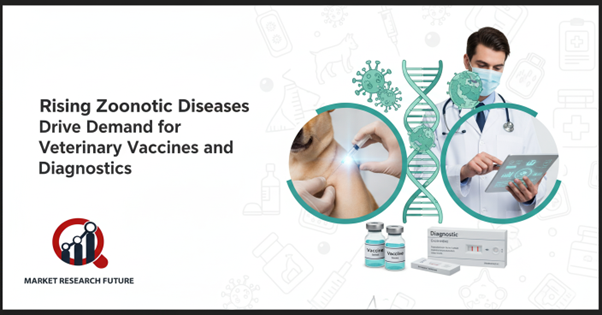The Rising Prevalence Of Zoonotic Diseases Upraises The Demand For Veterinary Vaccines And Diagnostics

The rise of zoonotic diseases is increasing the need for veterinary vaccines and tests.
Vaccines for animals are the first line of defense against the spread of diseases that can affect both animals and people. It is very important to protect the health of animals because people depend on them for food, protein, milk, wool, and leather. Vaccines for rabies, equine influenza, and foot-and-mouth disease are very important since they give the same kind of immunity as getting the disease naturally.
Why Vaccines for Animals Are Important
Vaccinating animals helps keep the food supply safer and stops the spread of infectious diseases. Healthy pets and livestock lower the risk of zoonotic infections, which are diseases that can spread from animals to people. The growing number of pets and animals in developing countries is driving up the need for good veterinary care. This is creating consistent growth prospects for the vaccine industry.
Things that drive the market
There are a number of things that are making the veterinary vaccines industry grow:
• More and more cases of zoonotic diseases.
• More people are adopting pets and the standards for veterinary treatment are getting higher.
• More people eating meat because the middle class is growing.
Even if there has been development, many farming areas still have trouble because people don't know how important immunizations are. To get the most out of veterinary vaccines, it's important to teach farmers and pet owners.
Different kinds and technologies
The market is divided into groups based on the type of animal and the type of vaccine. Vaccines are made for pets, birds, fish, and farm animals. Live attenuated vaccines, inactivated vaccines, recombinant vaccines, and toxoid vaccines are some of the most important technologies. These new ideas make animals' immunity safer, more effective, and last longer.
Effects of COVID-19
The COVID-19 pandemic had an effect on the veterinary vaccination business all around the world. Restrictions made pet owners and farmers stay away from clinics, which temporarily made it harder for them to get important vaccinations. But the pandemic also showed how important it is to combat zoonotic illnesses, which led to more attention being paid to animal health. As more people became vaccinated against COVID-19, people felt more confident in vaccines in general. This led to an increase in demand for veterinary vaccines.
Looking Ahead
The veterinary vaccinations industry is likely to keep growing as more people learn about, research, and invest in animal health. Vaccines not only keep animals healthy, but they also keep people healthy. As more people get pets and eat more meat around the world, veterinary vaccines and tests will continue to be important instruments for making the world a better and safer place.

Leave a Comment